Kompas, 1 April 2005
BARUS, sebuah nama daerah terpencil di pesisir pantai barat Sumatera Utara. Tetapi, sejarah daerah ini sebenarnya sangat tua, setua ketika kapal-kapal asing beribu tahun sebelum Masehi singgah mencari kapur barus di sana. Dari Barus pula, agama Islam dan Kristen pertama-tama dikenalkan ke seluruh Nusantara.
BARUS atau biasa disebut Fansur barangkali satu-satunya kota di Nusantara yang namanya telah disebut sejak awal abad Masehi oleh literatur-literatur dalam berbagai bahasa, seperti dalam bahasa Yunani, Siriah, Armenia, Arab, India, Tamil, China, Melayu, dan Jawa.
Berita tentang kejayaan Barus sebagai bandar niaga internasional dikuatkan oleh sebuah peta kuno yang dibuat oleh Claudius Ptolemaus, seorang gubernur dari Kerajaan Yunani yang berpusat di Alexandria, Mesir, pada abad ke-2.
Di peta itu disebutkan, di pesisir barat Sumatera terdapat sebuah bandar niaga bernama Barousai (Barus) yang menghasilkan wewangian dari kapur barus. Diceritakan, kapur barus yang diolah dari kayu kamfer dari Barousai itu merupakan salah satu bahan pembalseman mayat pada zaman kekuasaan Firaun sejak Ramses II, atau sekitar 5.000 tahun sebelum Masehi.
Berdasakan buku Nuchbatuddar tulisan Addimasqi, Barus juga dikenal sebagai daerah awal masuknya agama Islam sekitar abad ke-7. Makam tua di kompleks pemakaman Mahligai, Barus yang di batu nisannya tertulis Syekh Rukunuddin wafat tahun 672 Masehi atau 48 Hijriah, menguatkan adanya komunitas Muslim di daerah ini pada era itu.
Dewan Gereja-gereja di Indonesia juga memercayai sejak tahun 645 Masehi di daerah Barus telah masuk umat Kristen dari sekte Nestorian. Keyakinan tersebut didasarkan pada buku kuno tulisan Shaikh Abu Salih al-Armini. Sementara itu, penjelajah dari Armenia Mabousahl mencatat bahwa pada abad ke-12 telah terdapat Gereja Nestorian.
Penggalian arkeologi yang dilakukan oleh Daniel Perret dan kawan-kawannya dari Ecole francaise d’Extreme-Orient (EFEO) Perancis bekerja sama dengan peneliti Pusat Penelitian Arkeologi Nasional (PPAN) di Lobu Tua, Barus, membuktikan pada abad IX-XII perkampungan multietnis dari suku Tamil, China, Arab, Aceh, Jawa, Batak, Minangkabau, Bugis, Bengkulu, dan sebagainya juga telah ada di sana. Perkampungan tersebut dikabarkan sangat makmur mengingat banyaknya barang-barang berkualitas tinggi yang ditemukan.
Pada tahun 1872, pejabat Belanda, GJJ Deutz, menemukan batu bersurat tulisan Tamil. Tahun 1931 Prof Dr K A Nilakanta Sastri dari Universitas Madras, India, menerjemahkannya. Menurutnya, batu bertulis itu bertahun Saka 1010 atau 1088 Masehi di zaman pemerintahan Raja Cola yang menguasai wilayah Tamil, India Selatan. Tulisan itu antara lain menyebutkan tentang perkumpulan dagang suku Tamil sebanyak 1.500 orang di Lobu Tua yang memiliki pasukan keamanan, aturan perdagangan, dan ketentuan lainnya.
Namun, Lobu Tua yang merupakan kawasan multietnis di Barus ditinggalkan secara mendadak oleh penghuninya pada awal abad ke-12 sesudah kota tersebut diserang oleh kelompok yang dinamakan Gergasi.
"Berdasarkan data tidak adanya satu benda arkeologi yang dihasilkan setelah awal abad ke-12. Namun, para ahli sejarah sampai saat ini belum bisa mengidentifikasi tentang sosok Gergasi ini," papar Lucas Partanda Koestoro, Kepala Balai Arkeologi Medan.
Setelah ditinggalkan oleh komunitas multietnis tersebut, Barus kemudian dihuni oleh orang-orang Batak yang datang dari kawasan sebelah utara kota ini. Situs Bukit Hasang merupakan situs Barus yang berkembang sesudah penghancuran Lobu Tua.
Sampai misi dagang Portugis dan Belanda masuk, peran Barus yang saat itu telah dikuasai raja-raja Batak sebenarnya masih dianggap menonjol sehingga menjadi rebutan kedua penjajah dari Eropa tersebut. Penjelajah Portugis Tome Pires yang melakukan perjalanan ke Barus awal abad ke-16 mencatat Barus sebagai pelabuhan yang ramai dan makmur.
"Kami sekarang harus bercerita tentang Kerajaan Barus yang sangat kaya itu, yang juga dinamakan Panchur atau Pansur. Orang Gujarat menamakannya Panchur, juga bangsa Parsi, Arab, Bengali, Keling, dst. Di Sumatera namanya Baros (Baruus). Yang dibicarakan ini satu kerajaan, bukan dua," demikian catatan Pires.
Tahun 1550, Belanda berhasil merebut hegemoni perdagangan di daerah Barus. Dan pada tahun 1618, VOC, kongsi dagang Belanda, mendapatkan hak istimewa perdagangan dari raja-raja Barus, melebihi hak yang diberikan kepada bangsa China, India, Persia, dan Mesir.
Belakangan, hegemoni Belanda ini menyebabkan pedagang dari daerah lain menyingkir. Dan sepak terjang Belanda juga mulai merugikan penduduk dan raja-raja Barus sehingga memunculkan perselisihan. Tahun 1694, Raja Barus Mudik menyerang kedudukan VOC di Pasar Barus sehingga banyak korban tewas. Raja Barus Mudik bernama Munawarsyah alias Minuassa kemudian ditangkap Belanda, lalu diasingkan ke Singkil, Aceh.
Perlawanan rakyat terhadap Belanda dilanjutkan di bawah pimpinan Panglima Saidi Marah. Gubernur Jenderal Belanda di Batavia kemudian mengirim perwira andalannya, Letnan Kolonel Johan Jacob Roeps, ke Barus. Pada tahun 1840, Letkol Roeps berhasil ditewaskan pasukan Saidi Marah, yang bergabung dengan pasukan Aceh dan pasukan Raja Sisingamangaraja dari wilayah utara Barus Raya.
Namun, pamor Barus sudah telanjur menurun karena saat Barus diselimuti konflik, para pedagang beralih ke pelabuhan Sunda Kelapa, Surabaya, dan Makassar. Sementara, pedagang-pedagang dari Inggris memilih mengangkut hasil bumi dari pelabuhan Sibolga.
Barus semakin tenggelam saat Kerajaan Aceh Darussalam berdiri pada permulaan abad ke-17. Kerajaan baru tersebut membangun pelabuhan yang lebih strategis untuk jalur perdagangan, yaitu di pantai timur Sumatera, berhadapan dengan Selat Melaka.
Pesatnya teknologi pembuatan kapur barus sintetis di Eropa juga dianggap sebagai salah satu faktor memudarnya Barus dalam peta perdagangan dunia. Pada awal abad ke-18, Barus benar-benar tenggelam dan menjadi pelabuhan sunyi yang terpencil.
Kehancuran Barus kian jelas ketika pada tanggal 29 Desember 1948, kota ini dibumihanguskan oleh pejuang kemerdekaan Indonesia karena Belanda yang telah menguasai Sibolga dikabarkan akan segera menuju Barus.
>small 2small 0<, Barus yang berjarak 414 km dari Medan benar-benar dilupakan. Pemerintah lebih tertarik mengembangkan perdagangan di kawasan pantai timur Sumatera, khususnya di sekitar Selat Malaka, dengan pusatnya di Batam dan Medan.
Dominasi pembangunan pantai timur ini bisa dilihat pengiriman hasil bumi dari pedalaman pantai barat Sumatera yang harus melalui jalur darat untuk kemudian dibawa dengan kapal dari pelabuhan Belawan, Medan.
Sedangkan untuk melayani arus perdagangan skala lokal di kawasan pantai barat Sumatera, pemerintah lebih tertarik mengembangkan pelabuhan yang lebih baru seperti Singkil di utara dan Sibolga di selatan. Kehebatan Barus sebagai bandar internasional benar-benar dilupakan.
Kini, Barus tak lebih dari kota kecamatan lain di daerah pinggiran yang hampir-hampir tak tersentuh roda pembangunan. Sebagian warganya meninggalkan desa, mencari pekerjaan atau pendidikan di luar daerah.
"Kami yang tinggal di sini hanyalah warga sisa. Yang sukses atau yang berpendidikan enggan menetap di sini. Kota ini telah berhenti, tak ada dinamika, tak ada investasi," kata Camat Barus Hotmauli Sitompul. (AHMAD ARIF)
Thursday, June 28, 2007
Akhir Perjalanan Sejarah Barus
Posted by
Lefidus Malau
at
3:36 PM
3
comments
![]()
Labels: Penelitian
Wednesday, June 27, 2007
Hikayat Surat Batak
B. Si Mangarapintu menerima ilmu gaib dari Batara Guru.
C. Keterangan lanjut tentang "surat Batak".
D. Datu Guru Aji Ginagan menciptakan metode unik untuk mengajarkan huruf-huruf Batak.
1) Cerita terjadinya aksara (huruf) yang berbunyi "na".
2) Cerita terjadinya huruf (aksara) yang berbunyi "ha".
3) Terjadinya aksara yang berbunyi "ga " dan aksara yang berbunyi "la ".
4) Terjadinya aksara yang berbunyi "ba".
5) Terjadinya aksara yang berbunyi "pa".
6) Terjadinya aksara yang berbunyi "nga".
7) Terjadinya aksara yang berbunyi "ja".
8) Datu guru Aji Ginagan mengadakan ujian pertama.
9) Permulaan aksara yang berbunyi "da"
10) Terjadinya aksara yang berbunyi "ra".
11) Permulaan aksara yang berbunyi "ma"
12) Permulaan aksara surat Batak yang berbunyi "ta"
13) Permulaan aksara yang berbunyi "sa".
14) Datu Aji Bolak menemui kesulitan pertama.
15) Bagaimana tanda untuk vokal "i" diperoleh.
16) Guru Aji Ginagan melanjutkan pelajaran yang diberikannya.
17) Bagaimana tanda untuk menyatakan vokal "u" diperoleh.
18) Terjadinya tanda untuk menyatakan bunyi vokal "o"
19) Terjadinya tanda untuk menyatakan bunyi vokal "e".
20) Penemuan terjadinya aksara untuk bunyi "a".
21) Terjadinya tanda untuk menghilangkan bunyi "a" pada setiap aksara.
22) Apa sebabnya menulis "POS" tidak boleh:
23) Penemuan tanda yang baru untuk bunyi "ng"
24) Sebab terjadinya pertambahan dua buah aksara baru lagi.
25) Terjadinya aksara baru untuk bunyi "i" dan bunyi "u"
26) Datu guru Aji Ginagan mengakhiri "kuliah"-nya.
E. PENUTUP
Posted by
Lefidus Malau
at
1:15 PM
0
comments
![]()
Labels: Pustaha Batak
Friday, June 22, 2007
Tunggal Punaluan
 Batak shamans staff; 63" high.
Batak shamans staff; 63" high.
The Batak live in the northern part of Sumatra around Lake Toba and the priest's staffs are called tunggal punaluan. They usually feature a single figure on horseback or narrow figure tiers. This staff is unusual in that it has a standing single figure. (Indonesia, Sumatra, circa 1900)
Posted by
Lefidus Malau
at
5:13 PM
2
comments
![]()
Batak Mask
Tribal Masks Gallery
from: www.mccuetribalart.com Batak Mask, Sumatra Indonesia, dance mask with powerful expression. Soft patina from age 9 1/2" high Early to mid 20th century. From English collection previously in Calif.
Batak Mask, Sumatra Indonesia, dance mask with powerful expression. Soft patina from age 9 1/2" high Early to mid 20th century. From English collection previously in Calif.

Posted by
Lefidus Malau
at
4:46 PM
0
comments
![]()
EARRING "KUDUNG- KUDUNG"
from: www.shalimarbali.com Karo Batak, Brastagi, North Sumatra
Karo Batak, Brastagi, North Sumatra
Approximately 70 years
These handmade Kudung-Kudung are gilded silver earrings and were worn by Batak women during various ceremonies.
Posted by
Lefidus Malau
at
4:38 PM
0
comments
![]()
Musketball Holder
from: www.zkta.com
 Carved buffalo horn musketball holder with protective guardian face. Batak, Sumatra Island, Indonesia. 19th century. 8.5" high.
Carved buffalo horn musketball holder with protective guardian face. Batak, Sumatra Island, Indonesia. 19th century. 8.5" high.
Posted by
Lefidus Malau
at
4:28 PM
0
comments
![]()
Lute fret / Hacapi
from: www.zkta.com The portrait of a distinguished man adorns the finial of this lute fret from the Batak people of Sumatra. With a beautiful glossy patina, it measures 12-1/2" high and is mounted on a hardwood base.
The portrait of a distinguished man adorns the finial of this lute fret from the Batak people of Sumatra. With a beautiful glossy patina, it measures 12-1/2" high and is mounted on a hardwood base.


Posted by
Lefidus Malau
at
4:16 PM
0
comments
![]()
Labels: Batak Music Instruments, Batak Sculpture / Motif Ukiran Batak
Powder Container
from: www.joelcooner.com Batak Buffalo Horn Rifle Primer Powder Container
Batak Buffalo Horn Rifle Primer Powder Container
Details:
Origin: Batak People, Sumatra, Indonesia
Age: 19th Century
Materials: Wood and Buffalo Horn
Height: 5 1/2 inches high
Posted by
Lefidus Malau
at
3:48 PM
2
comments
![]()
Naga Morsarang
from: www.metmuseum.org Container for magical substances (naga morsarang), 19th–20th century
Container for magical substances (naga morsarang), 19th–20th century
Indonesia, Sumatra, Toba Batak people
Horn (buffalo), wood; H. 20 1/2 in. (52.1 cm)
Gift of Fred and Rita Richman, 1987 (1987.453.1)
Among the Batak people of Sumatra, the datu, or ritual specialist, required a variety of containers made of different materials to hold his supernaturally powerful mixtures and potions. This vessel, known as a naga morsarang, consists of the hollow horn of a water buffalo, its outer surface incised with curving foliate designs. In the interior of the horn, the earth deity Boraspati Ni Tano is represented in the form of a lizard, a motif that occurs on other ritual objects such as divination books.
The horn's pointed end is carved in the form of a seated human figure. The wider, open end is plugged with an elaborate wooden stopper that depicts the singa (a zoomorphic underworld deity) with four human figures riding on its back. These human figures may represent the succession of ritual masters who preceded the datu who owned the container. It is also possible that the figures are related to mythical characters portrayed on other ritual implements.
Posted by
Lefidus Malau
at
3:32 PM
1 comments
![]()
Staff finial / Tungkot Malehat
from: www.metmuseum.org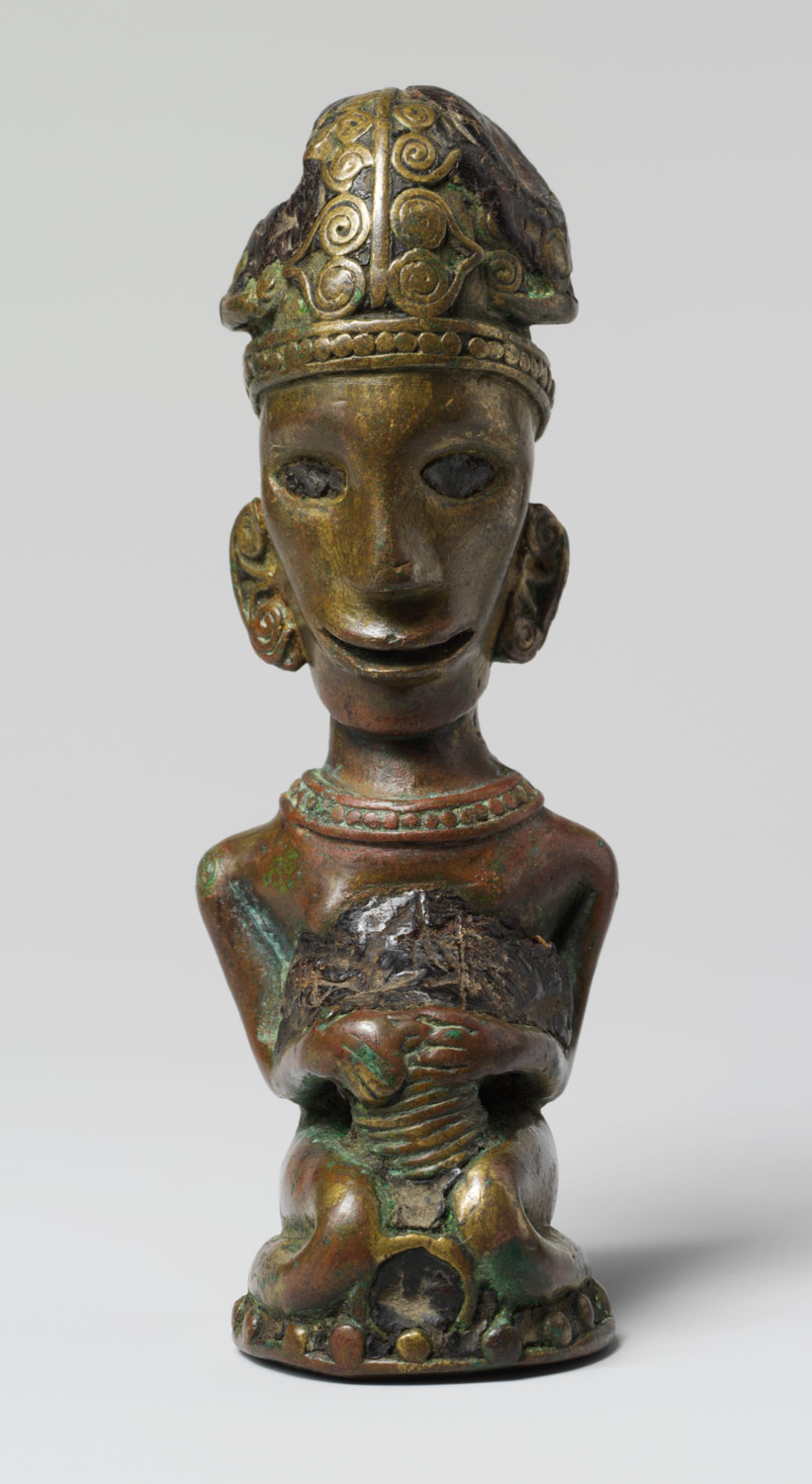 Staff finial, 19th–20th century
Staff finial, 19th–20th century
Indonesia, Sumatra, Batak people
Copper alloy; H. 4 1/2 in. (11.4 cm)
Gift of Fred and Rita Richman, 1988 (1988.143.141)
This kneeling figure likely served as the finial of a tungkot malehat, a type of ritual staff used by religious specialists among the Batak people of Sumatra. The tungkot malehat features a wooden or metal figure, as with the present example, that was often carved or cast separately and then joined to a staff of rattan or bamboo. A brass figure similar to this one and still attached to its wooden staff in the Volkenkundig Museum Nusantara, Delft, strongly suggests that the Metropolitan's piece served the same function.
The cast figure has a large head crowned by a helmetlike headdress decorated with double spirals and a beaded border. The figure wears a matching beaded torque around his neck and holds a cylindrical vessel in his lap. The image is hollow and filled with a dark, hardened substance, a magical preparation added to increase the object's supernatural efficacy. This powerful substance is visible through open sections of the headdress and above the small vessel in the figure's lap.
Posted by
Lefidus Malau
at
3:27 PM
0
comments
![]()
Puppet head (si galegale)
from: www.metmuseum.org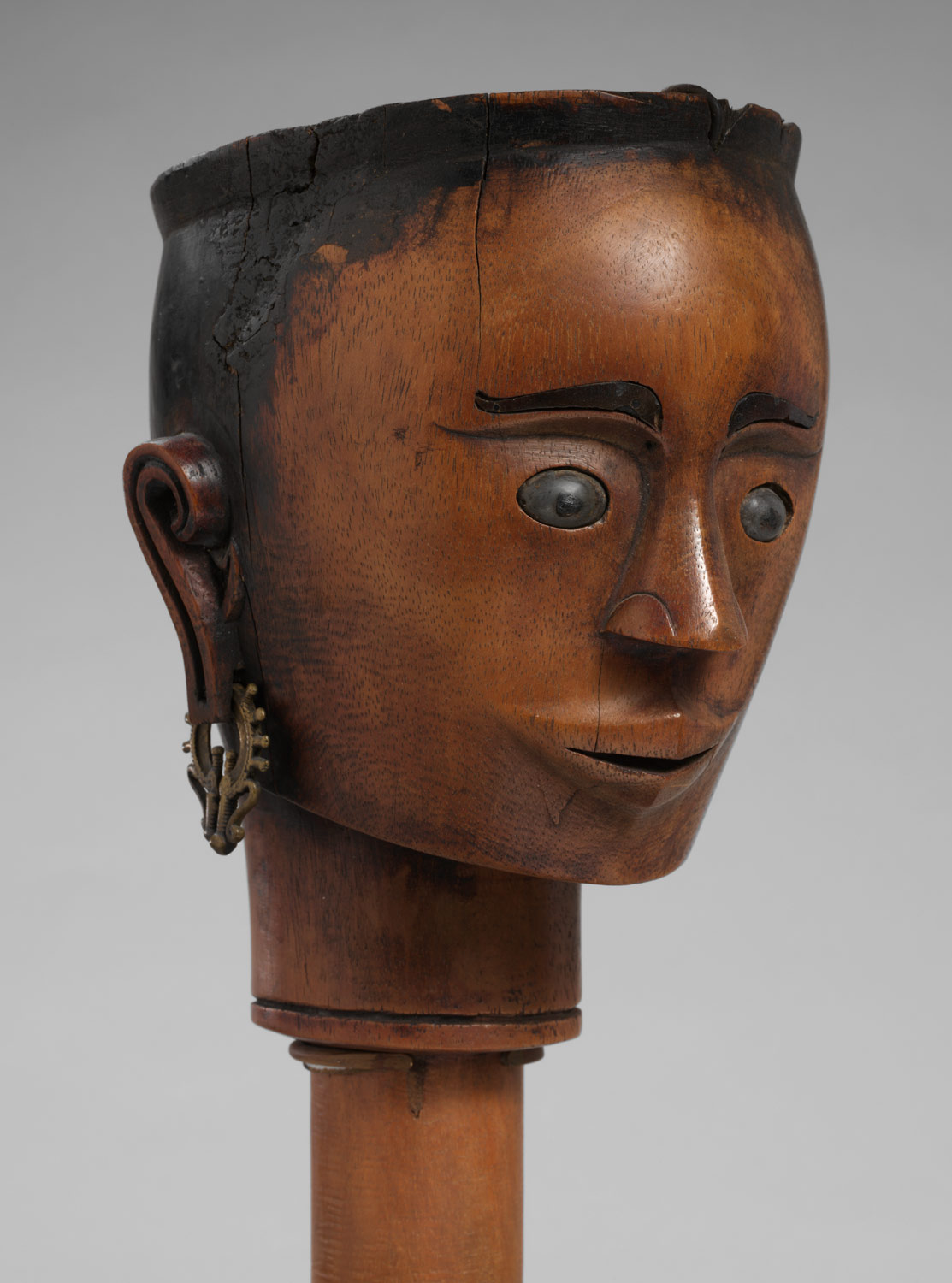 Puppet head (si galegale), 19th–20th century Indonesia, Sumatra, Batak, Toba Batak people.
Puppet head (si galegale), 19th–20th century Indonesia, Sumatra, Batak, Toba Batak people.
Wood, metal, horn, paint; H. 11 1/4 in. (28.6 cm)
Gift of Fred and Rita Richman, 1987 (1987.453.6)
A unique tradition within Batak sculpture are the puppets known as si galegale. In former times, si galegale appeared at funerals, where they served as stand-ins for the sons of men who had no male children to perform their mortuary rites. Moved by a complex system of internal strings controlled by a puppeteer, si galegale participated in funerary dances alongside the deceased's family. With the aid of moistened balls of moss inside its head, some were even able to shed tears for their dead fathers.
This si galegale's head is beautifully carved with delicate facial features, with inlaid eyes made of lead and pupils of resin. The curving eyebrows are inlaid with pieces of water buffalo horn, and the ears are adorned with brass ear ornaments, known as sitepal.
Posted by
Lefidus Malau
at
3:23 PM
0
comments
![]()
Labels: Batak Sculpture / Motif Ukiran Batak, Tales From Batak
Ceremonial textile (ulos ragidup)
from: www.metmuseum.org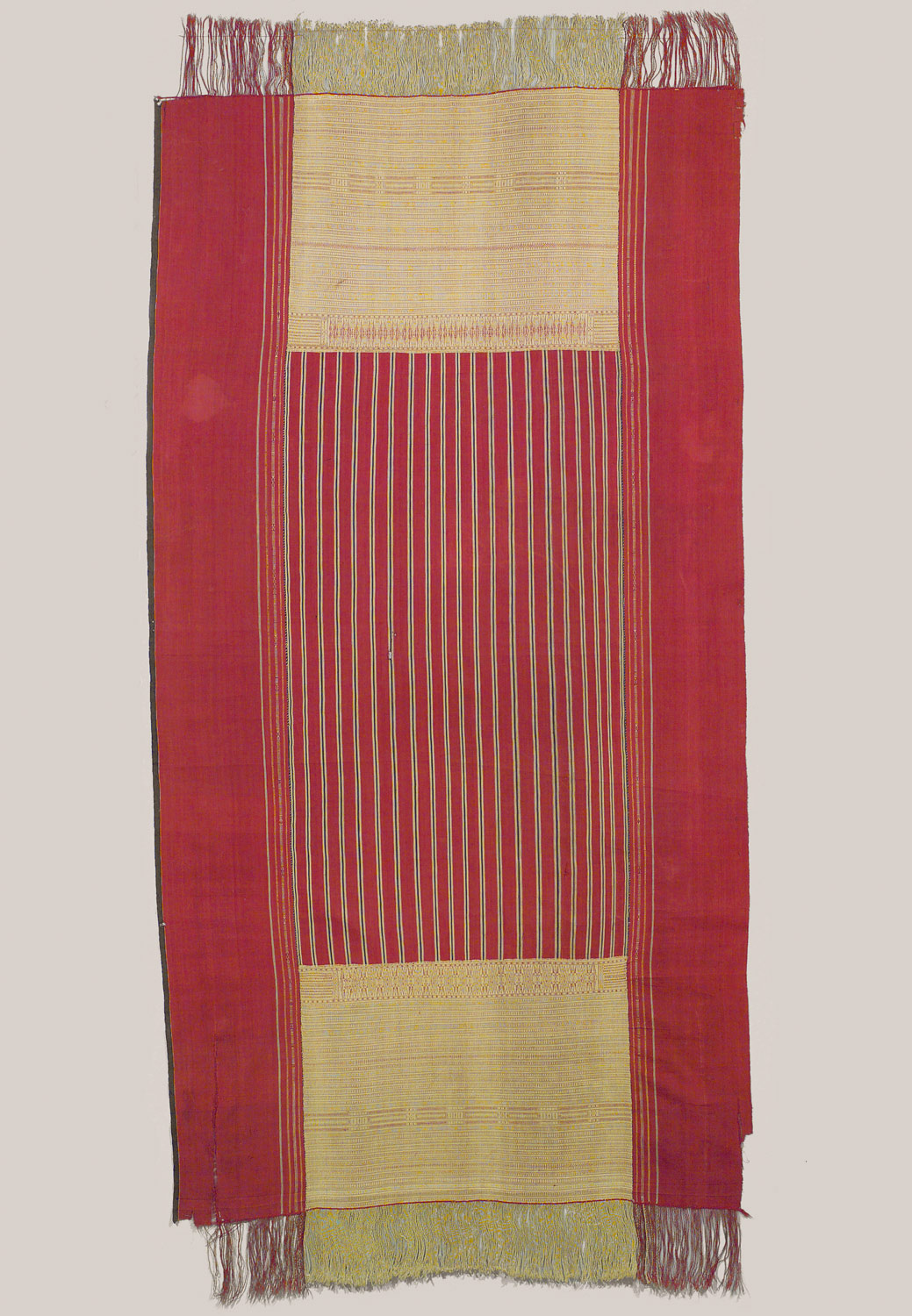 Ceremonial textile (ulos ragidup), 19th century
Ceremonial textile (ulos ragidup), 19th century
Indonesia, Sumatra, Toba Batak people
Cotton; L. 42 1/2 in. (108 cm)
Gift of Ernest Erickson Foundation Inc., 1988 (1988.104.25)
In the Toba Batak region, a particular type of textile, known as an ulos ragidup, was traditionally given to the mother of the bridegroom from the father of the bride at his daughter's wedding. This ceremonial exchange was meant to ensure the fertility of the couple and solidify the union of the two families. Occasionally, ulos ragidup were also used during funerary ceremonies to cover the exhumed bones of the dead or the exterior of a coffin.
This ulos ragidup consists of a wide central panel flanked by narrower strips on either side. The central panel is divided into three horizontal sections, with the two large end panels woven in white, and a middle panel adorned with fine white and dark blue stripes. By connecting the warp of the end panels to the warp of the central panel, the woman who created the textile was able to physically weave the three panels together as one, as opposed to sewing together three separate pieces. This ingenious weaving technique is unique to the Batak, and occurs nowhere else in Indonesia.
Posted by
Lefidus Malau
at
3:15 PM
0
comments
![]()
Labels: Batak Textile / Ulos Batak
Architectural ornament
from: www.metmuseum.org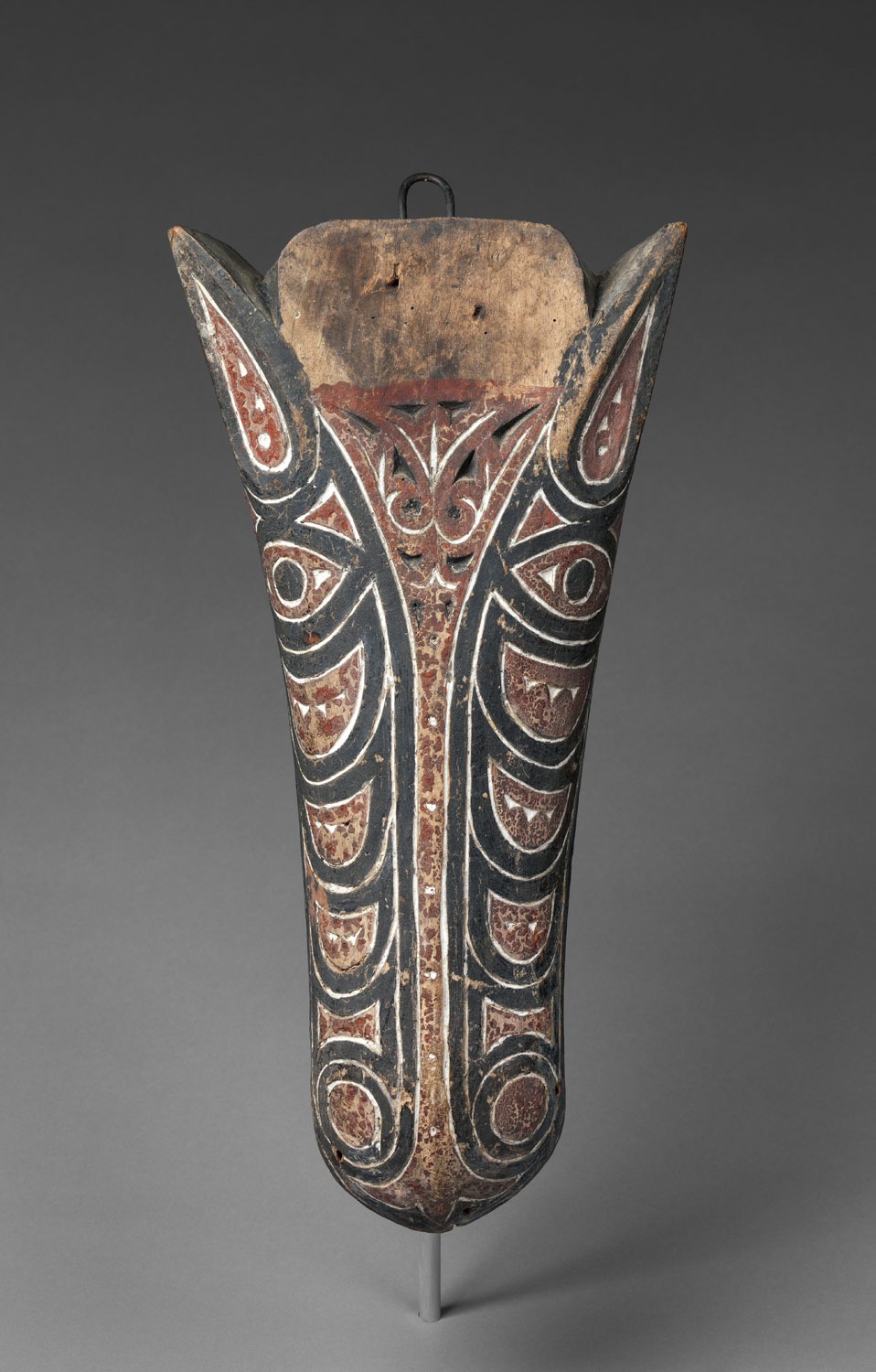 Architectural ornament, 19th–20th century
Architectural ornament, 19th–20th century
Indonesia, Sumatra, Toba Batak people
Wood, paint; H. 13 1/2 in. (34.3 cm)
Gift of Fred and Rita Richman, 1988 (1988.143.68)
Traditionally, Batak communal houses were richly decorated with geometric designs and naturalistic figures brightly painted in red, white, and black. The main decorative elements on the houses were large, carved animal heads incised with complex curvilinear motifs.
The architectural ornaments on the sides of the house consisted predominantly of horses' heads such as this one. These highly ornate pieces were not only decorative but also served as supernatural guardians that ensured the safety and security of the structure's inhabitants. In the Toba Batak region, horses were often consecrated to the three principal deities, and were believed to have the ability to transport individuals to the realm of the ancestors. They were also symbols of high status, since only the elite could afford to own them.
Posted by
Lefidus Malau
at
3:07 PM
0
comments
![]()
Wednesday, June 6, 2007
Guri guri
from: www.metmuseum.org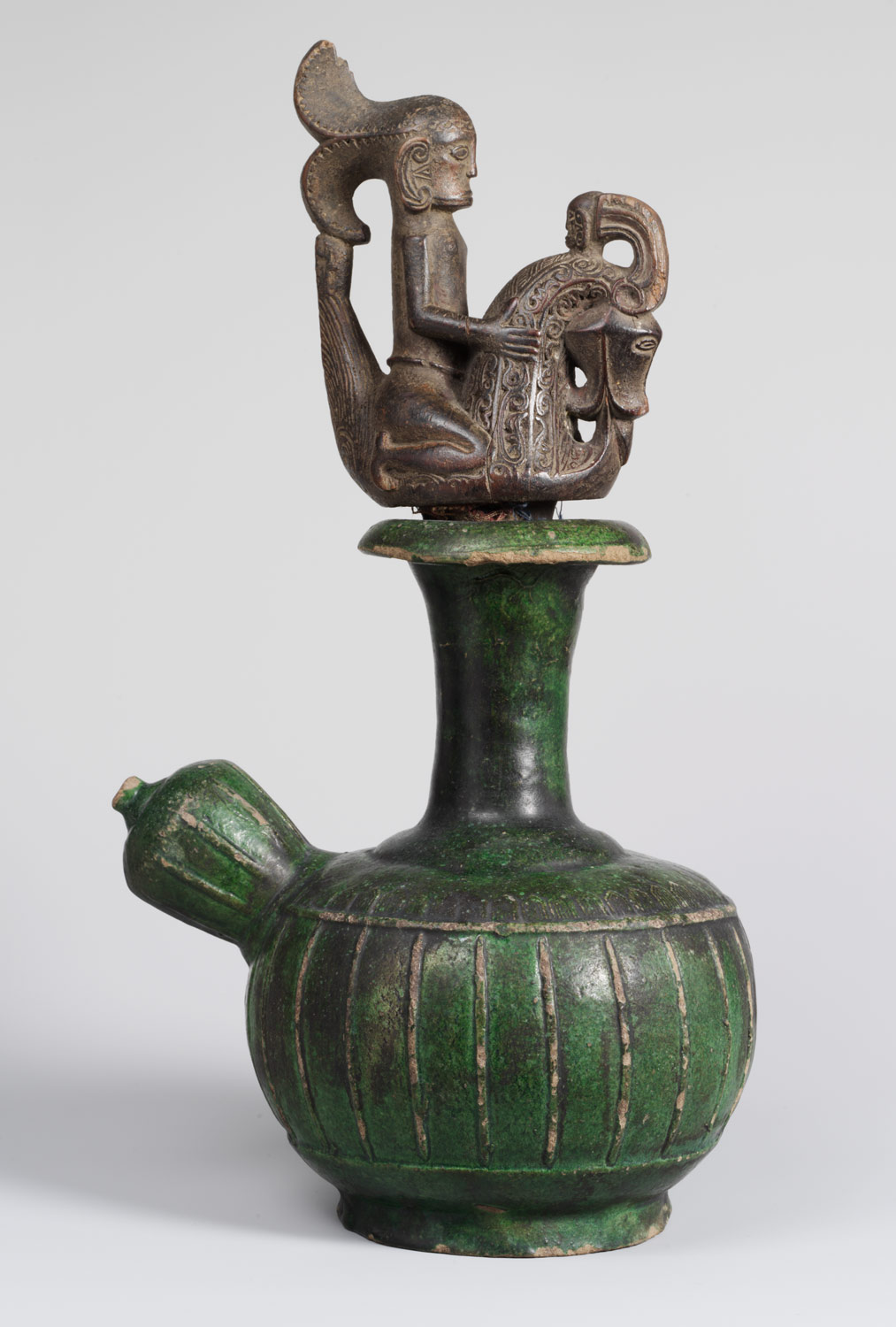 Container for magical substances (guri guri), 19th–early 20th century
Container for magical substances (guri guri), 19th–early 20th century
Indonesia, Sumatra, Toba Batak people
Wood, Chinese porcelain; H. 13 1/2 in. (34.3 cm)
Gift of Fred and Rita Richman, 1988 (1988.124.2a,b)
Container for magical substances (guri guri), 19th–early 20th century
Indonesia, Sumatra, Toba Batak people
Wood, Chinese porcelain; H. 13 1/2 in. (34.3 cm)
Gift of Fred and Rita Richman, 1988 (1988.124.2a,b)
Prior to the widespread adoption of Christianity in the early twentieth century, magic formed an important element of Batak religious practice. Religious specialists, known as datu, performed both benign and malevolent magic using a variety of ritual paraphernalia. The most sacred and powerful of the datu's objects was the potion container, or guri guri. These containers held pupuk, a powerful substance made from a ritually executed human victim. Pupuk, it was believed, could force the victim's spirit to do the datu's bidding.
The containers themselves were often imported Chinese ceramics, but the Batak carved elaborate wooden stoppers to seal the mouths of the vessels. Many stoppers, such as this example, depict human figures riding horselike creatures called singa. Combining aspects of horses, snakes, lions, and other animals, singa are mythical creatures associated with fertility and supernatural protection.
Posted by
Lefidus Malau
at
9:24 AM
0
comments
![]()
Ulos Batak
- Artifact Identification : Ulos, Ceremonial Textile
- Visual Description : Cream-colored textile with black and red-brown patterned stripes and tassles at top and bottom. Stripes are either black or red and are made up of geometric patterned elements, primarily triangular.
- Artist/Maker: None
- Geographic Location : Asia, Southeast, Sumatra, Lake Toba, Prapat
- Period/Date , Ca.: 1970’s
- Culture : Batak, Probably Toba Batak
Physical Analysis
- Dimension: 1 (Length) 133 cm
- Dimension: 2 (Width) 50 cm
- Dimension: 3 (N/A) N/A
- Weight : 152 g
- Measuring Remarks : Length includes tassles at both ends.
- Materials : Textile
- Manufacturing Processes : Weaving
- Munsell Color Information : N/A
- Published Description : N/A
- Scholarly Notes : Prapat is a primarily Toba Batak area. This textile is definately Batak and probably Toba Batak culture. this is an ‘ulos’ a textile used as a ceremonial gift for weddings and funerals. We have some examples in the teaching collection. Clark Cunningham, 2003.
- Comparanda : N/A
- Bibliography : N/A
- Archaeological Data : N/A
- Credit Line/Dedication : Gift of Ellen Cole Miller.
- Reproduction : N/A
- Reproduction Information : N/A
Posted by
Lefidus Malau
at
7:42 AM
1 comments
![]()
Labels: Batak Textile / Ulos Batak
Handcrafted Depiction of a Myth
 Handcrafted depiction of a myth from the Batak people of Sumatra.
Handcrafted depiction of a myth from the Batak people of Sumatra.
This wooden carving (17" tall and 17" wide with a 13" deep base) dates back to the mid-19th century. In Batak mythology, a boy who has left his family returns and unknowingly couples with his mother. As the sun rises and light enters the room, the mother sees his birthmark and realizes she is in her son's arms. The two confront and express their complex ranges of emotion. This is authentic folk art at its finest.
Posted by
Lefidus Malau
at
7:35 AM
0
comments
![]()
Batak Medicine Container
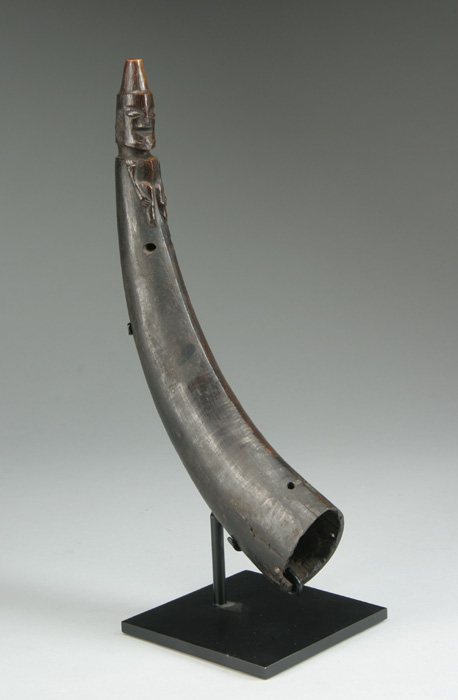 Batak medicine container made out of water buffalo horn with a sitting figure at the top. The stopper is missing, but the overall patina is good and dark from age and use. Previously sold at Christies Amsterdam from the collection of Herbert da Silva. 19th century, 10" tall, Sumatra, Indonesia.
Batak medicine container made out of water buffalo horn with a sitting figure at the top. The stopper is missing, but the overall patina is good and dark from age and use. Previously sold at Christies Amsterdam from the collection of Herbert da Silva. 19th century, 10" tall, Sumatra, Indonesia.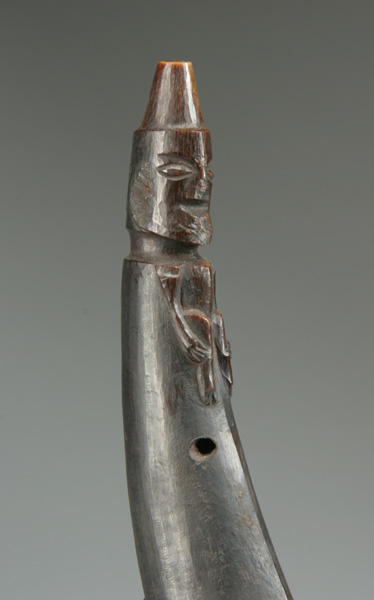
Posted by
Lefidus Malau
at
7:24 AM
0
comments
![]()
Batak Figurative Container
 Batak figurative container made from a section of Bamboo. The head removes to open the top, and the patina is thick and dark from storage and use. The height is 13", and the diameter is 4"
Batak figurative container made from a section of Bamboo. The head removes to open the top, and the patina is thick and dark from storage and use. The height is 13", and the diameter is 4"
Posted by
Lefidus Malau
at
7:21 AM
0
comments
![]()
Batak Musket Ball Holder
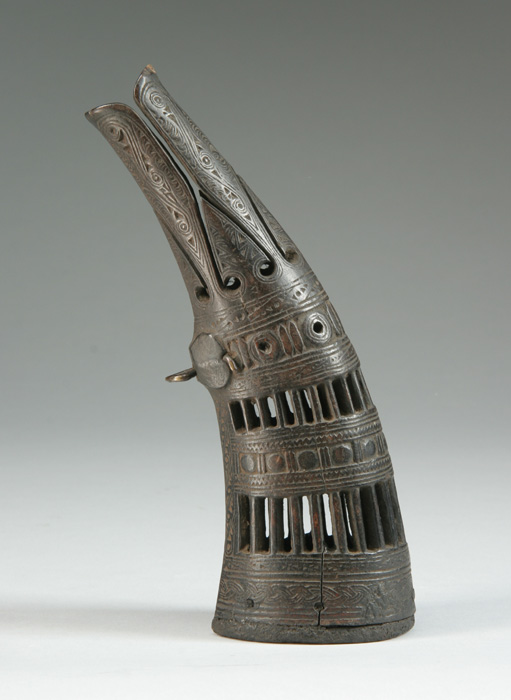 A very classic Batak musket ball holder made from intricately carved water buffalo horn. This well carved horn is capped with a wood end, and has a good patina from age and use. Previously sold at Christies Amsterdam from the collection of Herbert da Silva. 19th century, 8 1/2" tall, Sumatra, Indonesia.
A very classic Batak musket ball holder made from intricately carved water buffalo horn. This well carved horn is capped with a wood end, and has a good patina from age and use. Previously sold at Christies Amsterdam from the collection of Herbert da Silva. 19th century, 8 1/2" tall, Sumatra, Indonesia.
Posted by
Lefidus Malau
at
7:18 AM
0
comments
![]()
Batak House Panel
 Batak house panel with large Singha face. The mystical Singa figure is found on most traditional Batak houses, and many other works of art to ward off evil spirits. Late 19th or early 20th century with faint natural pigment colors still visible. Sumatra, 35" wide by 27" tall.
Batak house panel with large Singha face. The mystical Singa figure is found on most traditional Batak houses, and many other works of art to ward off evil spirits. Late 19th or early 20th century with faint natural pigment colors still visible. Sumatra, 35" wide by 27" tall.
Posted by
Lefidus Malau
at
7:14 AM
0
comments
![]()
Pustaha Batak --002
 Book of Batak priests. Written on a special piece of tree bark in a special language only understood by priests.
Book of Batak priests. Written on a special piece of tree bark in a special language only understood by priests.
Posted by
Lefidus Malau
at
6:54 AM
0
comments
![]()
Labels: Pustaha Batak
Bamboo Calendar
Batak Bamboo Calendar Batak Bamboo Calendar also functions as an oracle instrument to predict the future and devine or auspicious days for travel or rituals. The actually inscribing on the calendar is done by a Datu pupil (Toba Batak Priest). It has a beautiful natural patina from age. Most of the inscription is in good condition.
Batak Bamboo Calendar also functions as an oracle instrument to predict the future and devine or auspicious days for travel or rituals. The actually inscribing on the calendar is done by a Datu pupil (Toba Batak Priest). It has a beautiful natural patina from age. Most of the inscription is in good condition.
Material: Bamboo
Size: 12.5"x2"x2"
Country: Indonesia-Sumatra
Date: 19th-20th Century
Posted by
Lefidus Malau
at
6:47 AM
1 comments
![]()
Pagar
PAGAR - BATAK SHAMAN'S TALISMAN Material: Composite
Material: Composite
Region: Lake Toba
Dimensions: C. 8 inches
In THE ELOQUENT DEAD, edited by Jerome Feldman, page 87-88, it is stated that, "No matter what precautions are taken, there will be ancestors that have no place in the spirit world. These begu, or malevolent spirits, can be persuaded to take up residence in pagar - charms - and serve the men who control the pagar. Pagar means 'fence' and designates, according to Barbier, 'a natural or manufactured object....which has the power to keep away evil spirits or to protect against witchcraft' ". The pagar talisman would be activated by special incantations spoken by the shaman. This old pagar depicts a female figure with large, pointed breasts. Bone fragments are bound to the lower portion of the front of the figure with fiber cordage. A conical iron tip supports the figure above. Plugs in the head and abdomen seal the openings which have been filled with pukpuk, a ritually charged substance unique to the Batak. Good, old patina. 19th century.
Posted by
Lefidus Malau
at
6:42 AM
0
comments
![]()
House Pacel
HOUSE PANEL, LAKE TOBA BATAK Material: Wood
Material: Wood
Region: Lake Toba
Dimensions: C. 14 x 29 inches
Awesome older carved wood polychrome architectural panel from a traditional Lake Toba Batak house. This comes from an old home that was taken down in 1990. Note the definitive Singa motif. Packing and shipping will be USD25.00 for this item.
Posted by
Lefidus Malau
at
6:37 AM
0
comments
![]()
Batak Talsimanic
BATAK TALSIMANIC - CALENDAR CYLINDERS, ETCHED BAMBOO Material: Bamboo
Material: Bamboo
Region: Lake Toba
Dimensions: C. 13 inches
A pair of carved bamboo tubes from the Lake Toba Batak people of Sumatra, Indonesia. Rings made of water buffalo horn are inlaid into the top and bottom edge of each tube. Elaborate, fine, classic Batak etchings decorate the tubes. One cylinder features a twin centipede motif and a calendar. The other has a depiction of a large stylized scorpion, a gecko - lizard, and two centipedes. These creatures feature prominently in the Batak shaman's traditions and are featured on storage tubes for their talismanic - protective attributes. Ritual symbols and combinations of marks cover the surface of the bamboo, making these genuine Batak - crafted pieces wonderful objects for examination and contemplation.
Posted by
Lefidus Malau
at
6:34 AM
1 comments
![]()
BATAK SHAMANIC FIGURE Material: Wood
Material: Wood
Region: Lake Toba
Dimensions: C. 9 inches
An exceptional carved wood anthropomorphic shamanic figure from the Lake Toba Batak people of central Sumatra. Articulating arms. Good patina.
Posted by
Lefidus Malau
at
6:32 AM
0
comments
![]()
Shamanic Figure
BATAK SHAMANIC FIGURE Material: Wood
Material: Wood
Region:
Dimensions: C. 10 inches
Fine example of an older Lake Toba Batak carved wood shamanic figure. Squatting, on pedestal, female, articulating arms.
Posted by
Lefidus Malau
at
6:29 AM
0
comments
![]()
Shaman's Tube
BATAK SHAMAN'S TUBE, LARGE AND COMPLEX Material: Composite
Material: Composite
Region: Lake Toba
Dimensions: C. 32 inches
An exceptionally large and well crafted version of the Batak shaman's ritual storage container. Measures about 32 inches, overall. Large finial plug depicts the Batak mythic guardian beast, the Naga. A shamanic figure sits astride the Naga's head, holding a ritual bowl. The bottom of the tube is stoppered with a squatting ancestral figure. The surface of the tube is etched and incised with a myriad of traditional Batak designs, ritual symbols and marks, including a large shaman's calendar, designating the auspicious and inauspicious days in the ritual - ceremonial cycle. A fine and collectible example of the craft, not ancient, but authentic and made in the Lake Toba area of Sumatra.
Posted by
Lefidus Malau
at
6:26 AM
0
comments
![]()
Shaman's Oracle Bone
BATAK SHAMAN'S ORACLE BONE Material: Bone
Material: Bone
Region: Lake Toba
Dimensions: c. 15 inches
Carved and etched water buffalo rib bone from the Lake Toba Batak people of Sumatra, Indonesia. Used as a shaman's oracle bone, the etched and carved motifs include lizards, or geckos, a snake, a crab, and various arcane symbols. A classic Batak calendar is etched into the inner curve of the bone. Measures about 15 inches across the tips.
Posted by
Lefidus Malau
at
6:24 AM
0
comments
![]()
Shaman"s Medicine Container
BATAK SHAMAN'S MEDICINE CONTAINER, SUMATRA Material: Composite
Material: Composite
Region:
Dimensions: C. 12 inches
A classic Batak talismanic ancestral figure rides the legendary Naga beast on the stopper of this Lake Toba Batak medicine container. Hardwood finial stopper, incised bamboo tube, cow horn rings on upper and lower ends. Complex Batak designs etched into surface of bamboo, including a calendar that marks significant days for the use and non use of the tube's contents. Measures about 12 inches overall.
Posted by
Lefidus Malau
at
6:20 AM
0
comments
![]()
Batak Ring --001
BATAK RING, SUMATRA
Region: Indonesia
Dimensions:
A brass finger ring, featuring a warrior on a horse.
Posted by
Lefidus Malau
at
6:17 AM
0
comments
![]()
Batak Ring
BATAK RING, SILVER Material: Silver
Material: Silver
Region: Lake Toba
Dimensions:
Old silver ring from Sumatra, Batak people. Interesting, unique design. Strong, heavy, wearable. US ring size is 9.
Posted by
Lefidus Malau
at
6:14 AM
0
comments
![]()
Singa Naga
Batak Bracelet with Singa Naga Material: Metal
Material: Metal
Region: Lake Toba
Dimensions: C. 4 inches diameter
Classic heavy metal cast bracelet from the Lake Toba Batak people of central Sumatra. Double singa motif with geometric designs. Two lizards cling to the backs of the singas. The magical, mythical singa beast features prominently in Batak traditional thought. Part naga with elephantine elements, the singa motif occurs in jewelry, house panel designs, and shaman's paraphernalia.
Posted by
Lefidus Malau
at
6:10 AM
3
comments
![]()
Tuesday, June 5, 2007
Batak Drum

Left: NMM 2332. Drum, Batak tribe, Sumatra (Indonesia), 19th century. Bottom carved to resemble an old bronze cannon; traces of green pigment remain. Board of Trustees, 1977.
Center: NMM 1536. Handle drum, probably from Samoa, early 20th century. Arne B. Larson Collection, 1979.
NMM 1479. Handle drum, Trobriand Islands, early 20th century. Board of Trustees, 1976.
Posted by
Lefidus Malau
at
12:42 PM
0
comments
![]()
Labels: Batak Music Instruments


